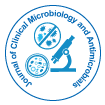
Journal of Clinical Microbiology and Antimicrobials
Open Access
+44-77-2385-9429

+44-77-2385-9429
Perspective - (2022)Volume 6, Issue 1
Acinetobacter is a genus of gram-negative bacteria belonging to the broader class of gammaproteobacteria. Acinetobacter species are oxidase-negative, exhibit twitching motility, and occur in pairs when enlarged.
They are important soil organisms, where they contribute to the mineralization of e.g. aromatic compounds. Acinetobacter species are a key source of infection in debilitated hospital patients, particularly Acinetobacter baumannii. Acinetobacter is a group of bacteria commonly found in soil and water and sometimes found on the skin of healthy people. There are many types or "species" of Acinetobacter that can cause human disease. The species Acinetobacter baumannii accounts for about 80% of reported infections. Outbreaks of Acinetobacter infection usually occur in hospital Intensive Care Units (ICUs) and healthcare facilities with very sick or disabled patients. Acinetobacter infection rarely occurs outside the healthcare setting.
Acinetobacter are easily isolated and cultured on conventional laboratory media without additional growth factor supplements. Commonly used laboratory media for growing Acinetobacter include organic medium 79, mineral medium with crude oil, peptone yeast extract medium, trypticase soy agar with glycerol, and trypticase phyton medium. Established selective and differential media such as Sellers agar, Herellea agar and MacConkey agar have also been used for the isolation of Acinetobacter. For drinking water samples, eosin-methylene blue agar can distinguish Acinetobacter from other heterotrophic organisms.
For better recovery of Acinetobacter species from the environment, samples can be spiked by adding 20 ml of acetatemineral medium to 5 ml of sample water or a filtered 10% soil suspension followed by vigorous aeration at 30˚C or room temperature.
Clinical isolates of Acinetobacter grow at 37˚C; some are able to grow at temperatures up to 42˚C. However, a temperature of 30˚C is often recommended for Acinetobacter growth. On nutrient agar and trypticase soy agar, Acinetobacter forms smooth, sometimes mucoid, pale yellow to grayish white colonies about 1–2 mm in diameter.
Identification
Identification, susceptibility testing and epidemiology of Acinetobacter spp. The application of various molecular methods to help generate accurate information in the health care setting is discussed. Acinetobacter is a uniquely successful organism that now poses unusual challenges for the detection and treatment of human disease. Classification of species within this genus has historically been difficult due to the genetic diversity of this organism. The application of various molecular typing methods was helpful in defining the 31 described Acinetobacter species, as phenotypic methods may not achieve an adequate level of speciation. Based on DNA sequence homology, A. baumannii-A. calcoaceticus complex consists of four members: A. baumannii, genospecies 3 and 13TU, and A. calcoaceticus. Of these, A. baumannii is the most clinically significant in human disease. Acinetobacter spp. has been isolated from extremely diverse environments and is well adapted to many sites on the human host. Pneumonia, bacteremia, and wound infection are the most common manifestations of Acinetobacter in the ICU. A. lwoffii is also a significant cause of nosocomial infections. A significant development is the emergence of Acinetobacter strains with resistance to multiple classes of antibiotics.
Symptoms
Acinetobacter baumannii is an opportunistic pathogen with a number of different diseases, each with its own symptoms. Some possible types of A. baumannii infections include:
• Pneumonia
• Blood stream infection
• Meningitis
• Wound and surgical site infections, including necrotizing fasciitis
• Urinary tract infection
Symptoms of Acinetobacter baumannii infections are often indistinguishable from other opportunistic infections caused by other opportunistic bacteria including Klebsiella pneumoniae and Streptococcus pneumoniae.
Symptoms of Acinetobacter baumannii infections, in turn, range from fever and chills, rash, confusion and/or altered mental states, pain or burning during urination, strong urge to urinate frequently, sensitivity to bright light, nausea (with or without vomiting), muscle pain and chest, trouble breathing, and coughing (with or without yellow, green, or bloody mucus). In some cases, A. baumannii may show no infection or symptoms, such as when colonizing an open wound or tracheostomy site.
Citation: Tefy I (2022) Identification of Acinetobacter Infection and its Symptoms. J Clin Microbiol Antimicrob. 06: 132
Received: 15-Mar-2022, Manuscript No. JCMA-22-20162; Editor assigned: 17-Mar-2022, Pre QC No. JCMA-22-20162 (PQ); Reviewed: 01-Apr-2022, QC No. JCMA-22-20162; Revised: 07-Apr-2022, Manuscript No. JCMA-22-20162 (R); Published: 15-Apr-2022 , DOI: 10.35248/JCMA. 22.6.132
Copyright: © 2022 Tefy I. This is an open-access article distributed under the terms of the Creative Commons Attribution License, which permits unrestricted use, distribution, and reproduction in any medium, provided the original author and source are credited.